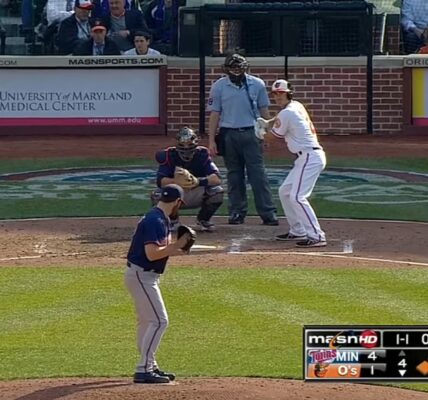Beyond the swings and pitches, baseball carries an intricacy that extends to player expressions, especially the seemingly straightforward act of drawing a line in the batter’s box. This article unveils the strategic dimensions behind this gesture, shedding light on how players employ it as a tactical move.
Consequences of Challenging Umpire Calls: The ‘Third Strike’ Dilemma
Central to the discussion is the pivotal ‘third strike’ scenario—a moment when player frustration might manifest as lines drawn in the dirt. Yet, this calculated expression can lead to ejection, emphasizing the delicate balance players must maintain between dissent and respecting the umpire’s authority.
Umpire’s Judgment
Umpiring, a blend of precision and subjectivity, involves factors like confidence, tolerance for outbursts, and past interactions. Understanding the umpire’s viewpoint is key to discerning when drawing a line transforms from a strategic move to an act of defiance.
Factors Influencing Umpire Decisions: The Human Element in Officiating
The human element introduces shades of subjectivity. Umpires vary in their leniency, with some impervious to player outbursts while others influenced by historical tensions. The ejection of a player may extend beyond the immediate incident, adding a layer of complexity.
Player-Umpire Dynamics
The dynamic between players and umpires extends beyond a single game. Series rotations and historical grievances create an undercurrent players need to navigate strategically, influencing the umpire’s perception.
Alternative Approaches for Players
Players facing a called third strike must evaluate their reactions strategically. Walking away from the moment and engaging in respectful dialogue ensures clarity without sacrificing sportsmanship, elevating the game’s atmosphere.
Navigating an Inconsistent Strike Zone
Inconsistencies in an umpire’s strike zone can be frustrating. Instead of confrontational gestures, players tactfully address concerns, fostering constructive dialogue and upholding the game’s spirit.
Explore the dynamics of games that end in a tie, a unique aspect of baseball.
Dealing with Umpire Mistakes
Umpires, inherently fallible, occasionally make mistakes. The 2010 incident with Armando Galarraga’s near-perfect game exemplifies the human aspect of officiating. Acknowledging errors, as umpire Jim Joyce did, humanizes the officiating process.
Discover the drawing a line in a real game here Batter ejected for drawing a line, a breakdown
The Unchangeable Nature of Calls
Once a call is made, it becomes part of the game’s narrative. Player arguments seldom overturn decisions. Embracing missed calls and allowing coaches to handle disputes acknowledges the inherent imperfection in officiating.
Choosing Sportsmanship Over Confrontation
Player ejections impact a team’s performance significantly. Prioritizing sportsmanship over confrontations preserves the game’s integrity, allowing teams to focus on strategic play without the distraction of emotional disputes.
Exploring Tactical Player Responses: Adapting to Varied Game Situations
Beyond the confines of ‘third strike’ scenarios, players showcase a myriad of responses to different in-game situations. Strategic adaptability becomes crucial as players navigate the complexities of a baseball game. Whether at bat, in the field, or on the base paths, every move contributes to the intricate chessboard of baseball strategy.
Defensive Maneuvers and Positioning
The strategic landscape expands with defensive maneuvers and positioning. Teams strategically shift fielders based on batter tendencies, optimizing their chances for successful plays. Exploring the nuances of defensive strategies adds depth to the understanding of how teams strategically position themselves to gain a competitive edge.
Pitching Strategies: A Mind Game Within the Game
Pitchers, often considered the chess masters on the mound, strategically employ various pitches and mind games to outsmart batters. Unveiling the strategic thinking behind pitch selection and psychological tactics enhances our understanding of the pitcher’s role in the baseball strategy.
Mastering the Pitch Framing
Catching, an often-underappreciated aspect of the game, involves strategic nuances, especially in pitch framing. Skilled catchers strategically position their mitts to influence umpire calls subtly. Understanding the art of pitch framing adds another layer to the strategic dynamics that unfold with every pitch.
The Evolution of Baseball Strategy
The advent of advanced analytics has revolutionized baseball strategy. Teams now employ data-driven approaches to player performance, defensive alignments, and even in-game decision-making. Delving into the role of analytics in shaping modern baseball strategy provides insights into the evolving nature of the game.
Innovations in Base Running
Base running is not just about speed; it’s a strategic dance between the runner and the defense. Innovations in base running tactics, such as delayed steals, hit-and-run plays, and strategic slides, showcase the ongoing evolution of strategic approaches to advancing on the base paths.
Conclusion
Drawing a line represents just one note in the vast composition of the game. Every aspect contributes to the rich tapestry of baseball strategy. As the game continues to evolve, so too will the strategic ingenuity displayed by players and teams on the diamond. Balancing tradition with innovation ensures that baseball remains a dynamic and strategically captivating sport for generations to come.




